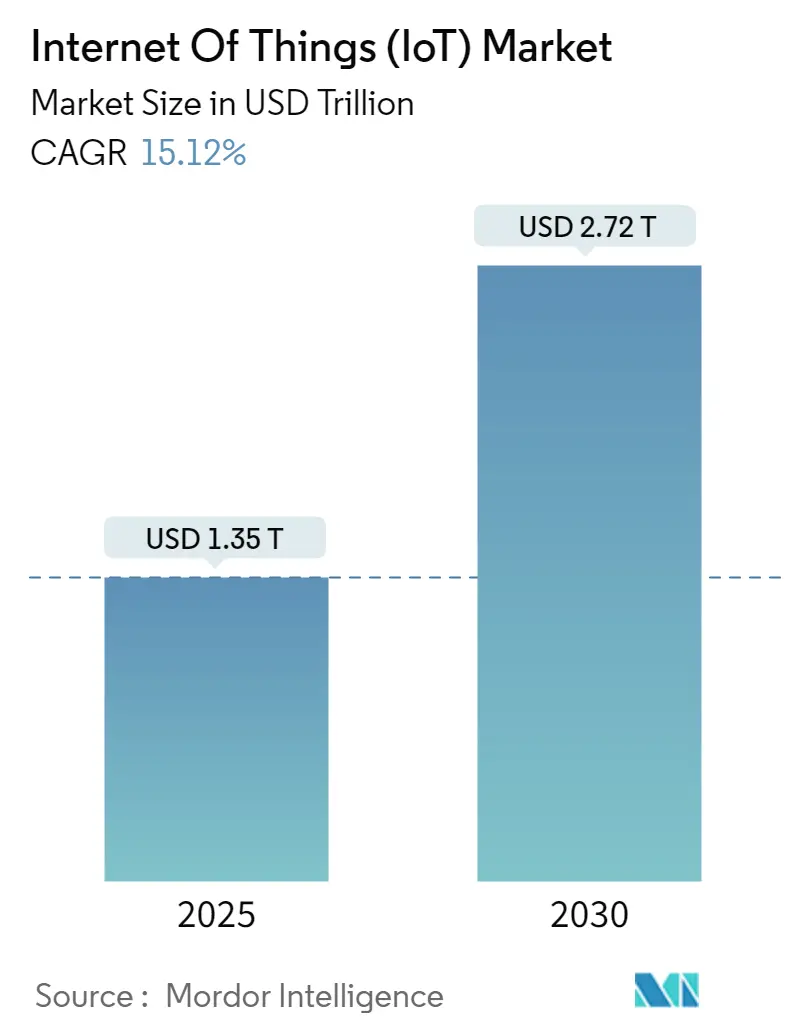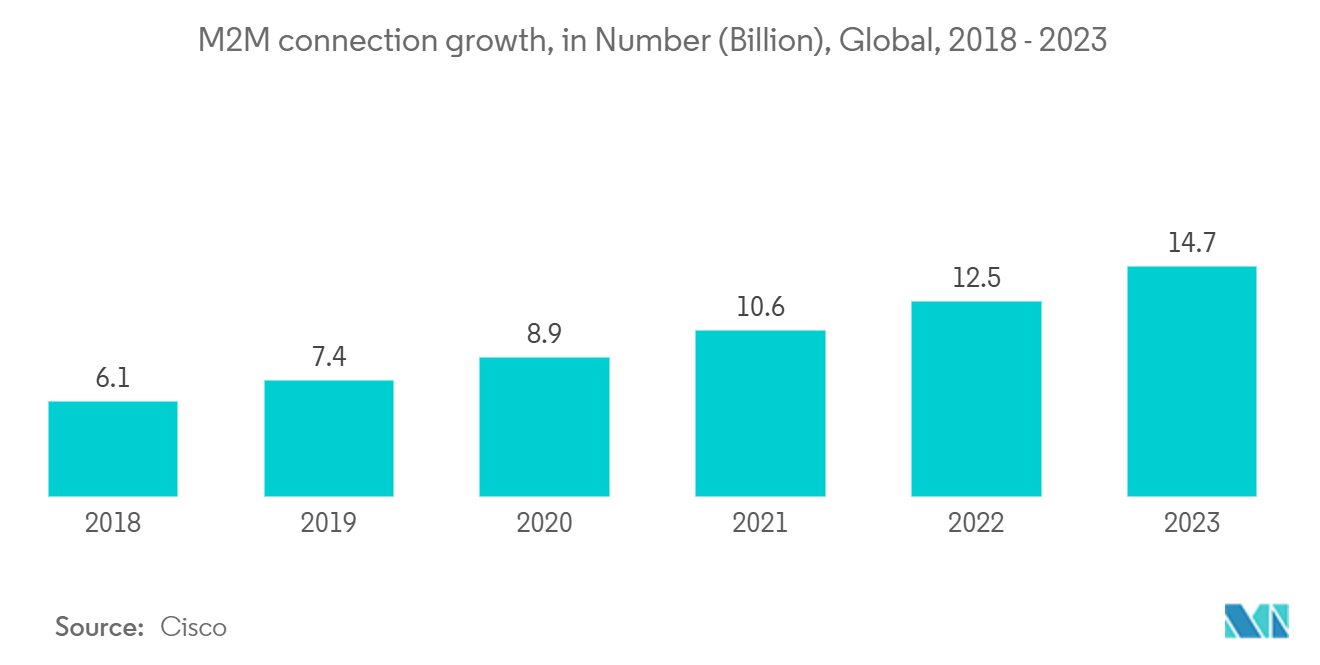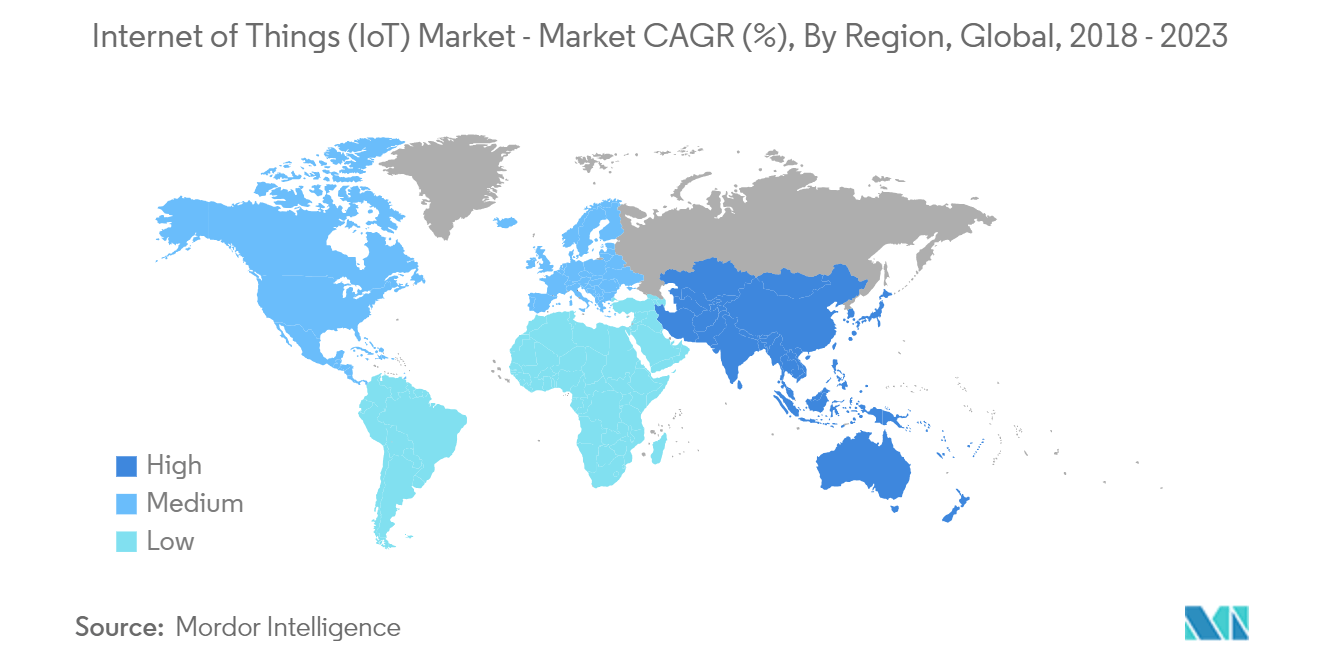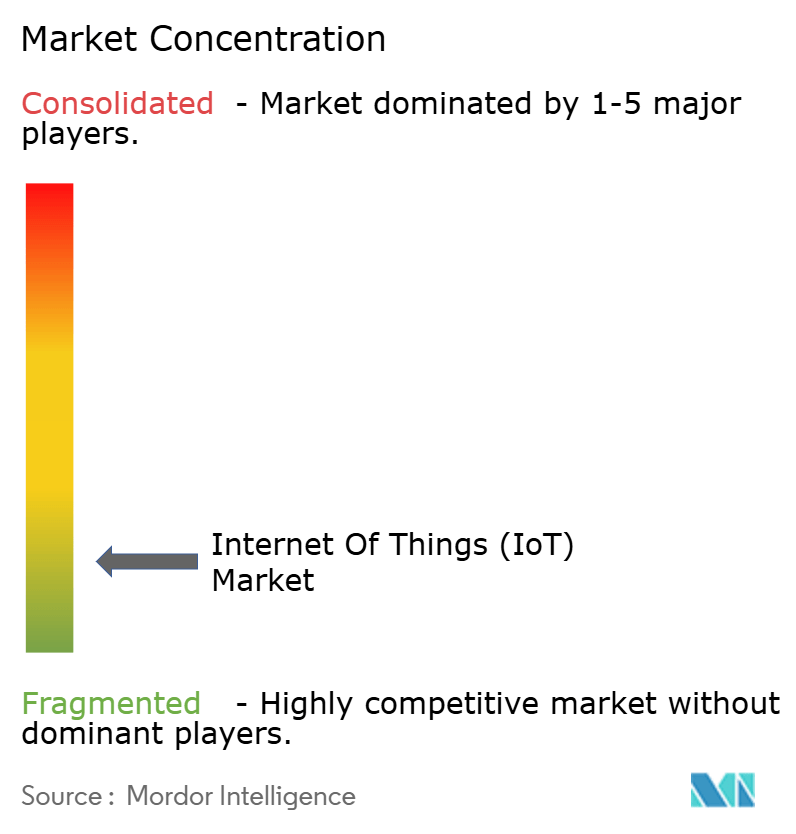Internet of Things (IoT) Market Analysis
The Internet Of Things Market size is estimated at USD 1.35 trillion in 2025, and is expected to reach USD 2.72 trillion by 2030, at a CAGR of 15.12% during the forecast period (2025-2030).
- IoT technology is the keystone for various organizations to digitally transform, thus empowering them to upgrade the existing processes by creating and tracking new business models. Enterprises and service providers have considered IoT the key enabler to augment digital transformation and unlock operational efficiencies. The growing adoption of IoT technology across end-user industries, such as manufacturing, automotive, and healthcare, is positively driving the market's growth. With the traditional manufacturing sector amid a digital transformation, IoT is fueling the next industrial revolution of intelligent connectivity.
- Industry 4.0 and IoT are central to new technological approaches for developing, producing, and managing the entire logistics chain, otherwise known as smart factory automation. Massive shifts in manufacturing due to Industry 4.0 and the acceptance of IoT require enterprises to adopt agile, smarter, and innovative ways to advance production with technologies that complement and augment human labor with robotics and reduce industrial accidents caused by process failure.
- With the high rate of adoption of connected devices and sensors and the enabling of M2M communication, there has been a surge in data points generated in the manufacturing industry. These data points can be of various kinds, ranging from a metric describing the time taken for the material to pass through one process cycle to a more advanced one, such as calculating the material stress capability in the automotive industry.
- The advancements in field devices, sensors, and robots are expected to expand the scope of the market further. IoT technologies are overcoming the labor shortage in the manufacturing sector. For more and more organizations, using Industry 4.0 technologies, like robotization, is part of day-to-day operations. According to the International Federation of Robotics, the market for collaborative robots is expected to reach USD 12.3 billion in two years. Intelligent robots work alongside workers and can be programmed by most factory workers to take on the most routine, tedious tasks and deliver accurately.
- IoT devices are vulnerable to cyberattacks, which create a potential risk of data exploitation and unauthorized access. Moreover, there are inconsistent security standards across IoT devices, which complicates the implementation of proper security measures and further restricts the market's growth.
- Post-COVID-19, IoT devices are increasingly used in the manufacturing industry to train and make workplace environments safer for humans by using them in potentially dangerous situations. Highly trainable and collaborative, robots also deliver safer working environments for humans by switching places with them in unsafe or unsuitable situations. IoT-enabled devices enhanced telehealth services' capabilities, facilitating more accurate diagnostics and continuous patient care, propelling the market growth.
Internet of Things (IoT) Market Trends
The Retail Segment to Witness a Significant Growth
- Both merchants and consumers have boosted the use of connected devices in the retail industry. The use of e-commerce and the rise in disposable income support the growth of supermarkets and hypermarkets. The usage of software and digitalization, along with the required internet access, presents a market potential for IoT devices in the market category.
- IoT is also anticipated to transition significantly in several domains, including replenishing inventory in storage facilities. Major electronics producers are releasing products like connected refrigerators that can automatically reorder cheese, milk, or any other item that is running low, including Samsung and LG.
- The retail industry has undergone significant transformations and innovations, with IoT technologies at the forefront. These technologies not only cater to evolving consumer habits but also empower retailers to deliver highly personalized shopping experiences. As a result, IoT solutions have revolutionized how retail management operates. Moreover, there is an increase in the use of e-commerce platforms owing to the growing smartphone penetration and the ease of online shopping.
- The critical applications of IoT for retailers include the supply chain, connected consumers, and smart-store applications. Retailers are turning to IoT-enabled solutions, as they help them improve customer engagement while increasing revenues and reducing costs.
- According to European Telecommunications Network Operators' Association (ENTO), in 2016, the retail sector had 1.53 million IoT active connections. Projections indicated that this number would grow significantly, reaching 3.09 million connections by 2025. This increase highlights the expanding role of IoT technology in enhancing retail operations and customer experiences.
North America to Witness a Significant Growth
- The deployment of connected vehicles, projects utilizing smart energy, home automation, and a focus on smart manufacturing are driving the expanding role of IoT among the region's crucial revenue-generating end-user industries. The North America expansion of IoT in this area has also been aided by fast digitalization across industry sectors and technological breakthroughs.
- The convergence of AI and IoT, promoted by firms like SAS Software as the next wave of IoT-based AI, is among the future technologies that are anticipated to arise out of the present technologies that are altering manufacturing in the United States. The utility sector is currently under intense pressure in the US. The US Energy Information Administration predicted worldwide energy demand will increase by 48% in 17 years, even though domestic energy production from renewable resources has expanded dramatically.
- The IoT sector, witnessing rapid expansion in North America, is propelled by the rising number of cloud platforms, a rise in connected devices, and the deployment of artificial intelligence and machine learning. Its applications are growing in smart homes, wearables, connected healthcare, and smart cities.
- The area is a pioneer in adopting container-based cloud applications that give deployments more flexibility and performance. Any centralized or edge IoT deployment is becoming accustomed to container-based cloud deployments. For instance, VMware introduced VMware Tanzu, a cloud platform that controls Kubernetes' container distribution.
- Additionally, the region is home to many startups developing ground-breaking IoT chip solutions. For example, a US startup, Wiliot, creates IoT chips based on Bluetooth technology without needing batteries for manufacturing, material recycling, retail, and asset distribution. These Bluetooth tags incorporate sensors, a low-power processor, and radio wave-based energy harvesting circuitry. The battery-free technology used by the startup offers much lower prices.
Internet of Things (IoT) Industry Overview
The Internet of Things (IoT) market is highly competitive owing to many large and small players operating in the domestic and international markets. Due to the high presence of technology, the market seems to be fragmented. Product innovation and mergers and acquisitions are two important methods the leading market participants use. Oracle Corporation, Cisco Systems Inc., Google Inc., IBM Corporation, and Microsoft Corporation are a few of the market's main participants.
In February 2024, Vi Business, the enterprise arm of Vodafone Idea, unveiled 'Vi Business IoT Smart Central,' a self-care platform designed for Internet of Things (IoT) connectivity and device management. This platform empowers companies to remotely control and manage their IoT assets in real time, enhancing the efficiency of their operations. Vi Business highlights that the platform not only streamlines the management of IoT assets but also offers insights to improve the SIM lifecycle and facilitates operations across diverse industries. Notably, Vi Business emphasizes that the platform's standout features include dynamic billing and customized rate plans, leveraging advanced analytics to tailor services based on usage patterns.
In January 2024, Actility and Hxperience announced a collaboration aimed at unveiling three innovative IoT solutions. These solutions started from a shared commitment to a sustainable, efficient, and health-focused world, targeting critical areas like building management, energy conservation, and well-being. Leveraging Hxperience's advanced SMATI software, building managers gain access to a comprehensive 360° monitoring system. This system, powered by LoRaWAN-connected sensors sourced from companies like Nexelec and Watteco, delivers actionable insights. These insights, in turn, enhance equipment performance, optimize energy consumption, and elevate occupant well-being.
Internet of Things (IoT) Market Leaders
-
Cisco Systems, Inc.
-
Google, Inc.
-
IBM Corporation
-
Microsoft Corporation
-
Huawei Technologies Co. Ltd
- *Disclaimer: Major Players sorted in no particular order
Internet of Things (IoT) Market News
- June 2024: Tata Consultancy Services (TCS), a prominent player in IT services and consulting, unveiled its 'Bringing Life to ThingsTM Lab' in Cincinnati, Ohio. This lab is tailored for swift prototyping, extensive experimentation, and the deployment of AI, GenAI, and IoT engineering solutions. Through this initiative, TCS aims to expedite and streamline the process of implementing advanced solutions for its clients.
- February 2024: Cisco and TELUS have jointly unveiled their latest 5G offerings in North America, specifically tailored to cater to IoT applications in various industry verticals, notably emphasizing connected cars. This 5G network is primed to facilitate drive testing for a prominent North American automotive manufacturer's 5G Connected Car, enabling improved customer experiences and new revenue streams for automakers.
Internet of Things (IoT) Industry Segmentation
IoT is a network of internet-connected objects. These objects collect and exchange data using sensors embedded within them. IoT has combined hardware and software with the internet to create a more technically driven environment. The scope of study on the IoT market is structured to track the spending on hardware, platforms, and services across end-user industries, such as manufacturing, transportation, retail, healthcare, energy, and utilities.
The Internet of Things (IoT) Market is segmented by component (hardware, software/platform, connectivity, and services), end-user industry (manufacturing, transportation, healthcare, retail, energy and utilities, residential, government, and insurance), and geography (North America, Europe, Asia-Pacific, Latin America, Middle-East and Africa).
The market sizes and forecasts are provided in terms of value (USD) for all the above segments.
| By Component | Hardware |
| Software/Platform | |
| Connectivity | |
| Services | |
| By End-user Industry | Manufacturing |
| Transportation | |
| Healthcare | |
| Retail | |
| Energy and Utilities | |
| Residential | |
| Other End-user Industries | |
| By Geography*** | North America |
| Europe | |
| Asia | |
| Australia and New Zealand | |
| Latin America | |
| Middle East and Africa |
Internet Of Things (IoT) Market Research Faqs
How big is the Internet Of Things Market?
The Internet Of Things Market size is expected to reach USD 1.35 trillion in 2025 and grow at a CAGR of 15.12% to reach USD 2.72 trillion by 2030.
What is the current Internet Of Things Market size?
In 2025, the Internet Of Things Market size is expected to reach USD 1.35 trillion.
Who are the key players in Internet Of Things Market?
Cisco Systems, Inc., Google, Inc., IBM Corporation, Microsoft Corporation and Huawei Technologies Co. Ltd are the major companies operating in the Internet Of Things Market.
Which is the fastest growing region in Internet Of Things Market?
Asia Pacific is estimated to grow at the highest CAGR over the forecast period (2025-2030).
Which region has the biggest share in Internet Of Things Market?
In 2025, the North America accounts for the largest market share in Internet Of Things Market.
What years does this Internet Of Things Market cover, and what was the market size in 2024?
In 2024, the Internet Of Things Market size was estimated at USD 1.15 trillion. The report covers the Internet Of Things Market historical market size for years: 2019, 2020, 2021, 2022, 2023 and 2024. The report also forecasts the Internet Of Things Market size for years: 2025, 2026, 2027, 2028, 2029 and 2030.
Our Best Selling Reports
Internet Of Things (IoT) Industry Report
The global Internet of Things (IoT) market is experiencing significant market growth, driven by the integration of low-cost sensors, high-speed connectivity, cloud adoption, and data analytics. This market overview highlights the transformative potential across various sectors such as healthcare, manufacturing, transportation, and retail. The market segmentation includes components like hardware, software/platform, connectivity, and services, catering to diverse end-user industries including manufacturing, transportation, healthcare, retail, energy and utilities, residential, government, and insurance.
The industry trends indicate that software solutions are expected to lead the market, enhancing operational efficiencies and customer experiences. North America is set to dominate the market due to its technological advancements, while the Asia Pacific region is predicted to see the highest growth, driven by urbanization and smart city projects. The industry outlook remains promising despite challenges such as communication technology advancements in developing economies and a lack of IoT awareness.
The report pdf provides detailed insights and forecasts, offering valuable market data and market statistics. The industry analysis reveals that the IoT market's growth rate is supported by the proliferation of connected devices and emerging technologies like 5G. Market leaders are capitalizing on these opportunities, contributing to the overall market value.
For a comprehensive understanding of the market structure, market forecast, and market predictions, the report example offers an in-depth industry report. This includes market review and market segmentation, providing a clear market overview and market outlook. The industry size and industry information are crucial for research companies and those interested in industry research.
In conclusion, the IoT market's market growth is bolstered by various factors, and the industry reports available in the report pdf offer a detailed market analysis. The industry statistics and market data are essential for understanding the market's potential and the opportunities for market leaders. The market forecast and market predictions indicate a positive trajectory for the IoT market, making it a key area of focus for industry research and market review.

_Market_company_logog.webp)





